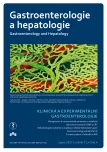Adenocarcinoma of the small intestine as an unusual cause of hypochromic anemia
Authors:
S. Kysela 1; D. Frajerová 1; L. Hadraba 1; M. Samek 2
Authors‘ workplace:
Interní oddělení II, Nemocnice Teplice, o. z., Krajská zdravotní, a. s., Teplice
1; Interní a gastroenterologická ordinace Most
2
Published in:
Gastroent Hepatol 2017; 71(4): 333-336
Category:
Gastrointestinal Oncology: Case Report
doi:
https://doi.org/10.14735/amgh2017csgh.info03
Overview
In this particular case of a patient with hypochronic anemia dissipation character, we highlight the pitfalls encountered in diagnosing this relatively rare adenocarcinoma of the small intestine. In the discussion section, we show that algorithms used in outpatient clinics or by hospital doctors unnecessarily complicate diagnosis by engendering multiple basic endoscopy interventions and conversely methods from which it is already in medicine diversion. On the other hand, it should be noted that the availability of sophisticated investigative techniques, such as enteroscopy and capsule endoscopy, is still not optimal in some regions. Physicians often face long order deadlines, which can discourage patients and reduce cooperation with the doctor. A good prognosis and five-year patient survival depends on an early diagnosis and radical surgery. Clinical symptoms are relatively inconspicuous and the physician must be attentive to subtle changes in the patient. When significant symptoms are apparent, such as palpable resistance or disorders passages, the patient is often in the advanced stage of the disease and radical surgery is impossible. In these cases, only palliative surgery followed by oncology therapy or purely symptomatic treatment is applicable. The average time to diagnosis takes between 8 and 12 months or longer. The clinician should not be content with one negative result if there is still a suspicion of an organic cause. The patient should be properly investigated and in case of doubt, the doctor should not be afraid to ask for a consultation with another specialist or the doctor should encourage the patient to visit a clinic more specialized in the disease.
Key words:
bleeding – small intestine – adenocarcinoma – anemia – colonoscopy – capsule endoscopy
The authors declare they have no potential conflicts of interest concerning drugs, products, or services used in the study.
The Editorial Board declares that the manuscript met the ICMJE „uniform requirements“ for biomedical papers.
Submitted:
8. 6. 2016
Accepted:
20. 11. 2016
Sources
1. Howe JR, Karnell LH, Menck HR et al. The American College of Surgeons Commission on Cancer and the American Cancer Society. Adenocarcinoma of the small bowel: review of the National Cancer Data Base, 1985–1995. Cancer 1999; 86 (12): 2693–2706.
2. Jurgoš L, Kužela L, Hrušovský Š et al. Gastroenterológia. Bratislava: VEDA 2006 : 688.
3. Ústav zdravotnických informací a statistiky ČR, Národní onkologický registr ČR. Novotvary 1999 ČR. Praha: ÚZIS ČR 2002 : 56.
4. Veyrières M, Baillet P, Hay JM et al. Factors influencing long-term survival in 100 cases of intestine primary adenocarcinoma. Am J Surg 1997; 173 (3): 237–239.
5. Placák B. Nádory tenkého střeva v československém písemnictví. Čas lék čes 1964; 103 (41): 1121–1135.
6. Yamada T. Atlas of gastroenterology. Michigan: Wiley-Blackwell 2009 : 1207.
7. Lochmannová J. Možnosti užití M2A endoskopické kapsle. Given diagnostic imaging system. In: Bulletin HPB 2002; 10 (2–3): 73–74.
8. Liangpunsakul S, Maglinte DD, Rex DK. Comparison of wireless capsule endoscopy and conventional radiologic methods in the diagnosis of small bowel disease. Gastrointest Endosc Clin N Am 2004; 14 (1): 43–50.
9. Friedman S. Comparison of capsule endoscopy to other modalities in small bowel. Gastrointest Endosc Clin N Am 2004; 14 (1): 51–60.
10. Gerson LB, Fidler JL, Cave DR et al. ACG Clinical Guideline: Diagnosis and management of small bowel bleeding. Am J Gastroenterol 2015; 110 (9): 1265–1287. doi: 10.1038/ajg.2015.246.
11. Zogala D. Diagnostika chorob GIT metodami nukleární medicíny. Postgraduální gastroenterol hepatol 2016; 2 (2): 113–117.
12. Tang SJ, Haber GB. Capsule endoscopy in obscure gastrointestinal bleeding. Gastrointest Endosc Clin N Am 2004; 14 (1): 87–100.
13. Falt P, Urban O, Vítek P et al. Koloskopie. Praha: Grada publishing 2015 : 320.
14. Válek J, Matějovská B. Neobvyklý zdroj krvácení do gastrointestinálního traktu. Gastroent Hepatol 2014; 68 (6): 488–491.
Labels
Paediatric gastroenterology Gastroenterology and hepatology SurgeryArticle was published in
Gastroenterology and Hepatology

2017 Issue 4
- Metamizole at a Glance and in Practice – Effective Non-Opioid Analgesic for All Ages
- Metamizole in perioperative treatment in children under 14 years – results of a questionnaire survey from practice
- Obstacle Called Vasospasm: Which Solution Is Most Effective in Microsurgery and How to Pharmacologically Assist It?
- Possibilities of Using Metamizole in the Treatment of Acute Primary Headaches
- Metamizole vs. Tramadol in Postoperative Analgesia
Most read in this issue
- Outcome of treatment of Helicobacter pylori infection based on microbiological susceptibility testing following the unsuccessful second-line eradication treatment
- Self-expandable coated metal Danis stent as a bridge to liver transplantation
- Acute appendicitis – a rare complication of colonoscopy
- Graft-duodenal fistula – a cause of massive gastrointestinal bleeding
